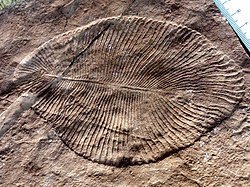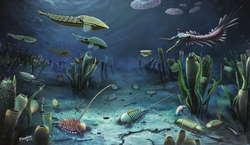Cambrian


The Cambrian is the first geological period of the Palaeozoic era and the Phanerozoic eon. It lasted from 541 million years ago to 485.4 million years ago.[1] Before it came the Ediacaran, and after it the Ordovician.
Biologists have learnt quite a lot about the soft parts of Cambrian animals. This is because places have been found where soft parts of organisms are preserved as well as their more resistant shells. This means our understanding of the Cambrian biota is better than that of some later periods.
Life on Earth changed greatly during the Cambrian period. Before the Cambrian, life was mostly small and simple. Complex organisms (metazoa) evolved during the Proterozoic era. But during the Cambrian period, some organisms used carbonate minerals for shells, so they had hard parts which could become fossils. There were many different kinds of life during the Cambrian period. This increase in the diversity of lifeforms was relatively rapid, and is called the Cambrian explosion. This adaptive radiation produced the first members of the main groups of animals, called phyla.
Almost all of this new life was in the oceans. There was little life on land except a layer of microbes. There were shallow seas near several continents, because a supercontinent called Pannotia had broken into smaller pieces. The seas were warm, and there was no ice at the North and South Pole. Many animals with hard shells appeared for the first time during the beginning of the Cambrian.
Change in the sea floor
At the start of the Cambrian, the earlier animals (the Ediacaran biota) may have become extinct.[2] It seems these older life forms were affected by new types which burrowed into the sea floor.[3] This changed the conditions of life for the older types. The burrowing must have disturbed the mat of bacteria and algae which covered the sea-floor. About this time we find the first examples of many phyla. There are also some fossil traces on what was land at the time, so perhaps a few Cambrian organisms did leave the water.
Fossils
Fossils from the Cambrian period sometimes show what the soft parts were like, unlike most fossils where the soft parts disappear. Fossils from the Burgess Shale in Ontario, Canada are examples of fossils with soft parts.[4] Here are some life forms that first appeared in the Cambrian period, with the oldest ones first:
- First Cnidaria, and probable annelids, about 580 million years ago, in the Ediacaran period.
- Small shelly fossils (SSF), including first molluscs and brachiopods, about 537 million years ago.[5]
- First trilobites, about 526 million years ago.
- First echinoderms, about 522 million years ago.
- First crustaceans, about 510 million years ago.
It is not always clear which phylum a fossil should be put into. So there are some fossils which are still being discussed, years after they were discovered.
Cambrian Media
Ediacaran-Cambrian boundary section at Fortune Head, Newfoundland, GSSP
Diorama of the Burgess Shale Biota
Approximate positions of Gondwana, Laurentia and Baltica in the middle Cambrian (c. 500 Ma). AT: Armorican terrane, CA: Carolinia, CU: Cuyania, EA: East Avalonia, FA: Famatina arc, GA: Ganderia, IB: Iberia, MX: Mixteca–Oaxaca block, WA: West Avalonia. Plate boundaries: red - subduction; white - ridges; yellow - transform.
Archeocyathids from the Poleta formation in the Death Valley area
A reconstruction of Margaretia dorus from the Burgess Shale, which were once believed to be green algae, but are now understood to represent hemichordates
Artistic reconstruction of Marjum biota, including various arthropods (trilobites, hymenocarines, and radiodonts), sponges, echinoderms, and various other groups
Stromatolites of the Pika Formation (Middle Cambrian) near Helen Lake, Banff National Park, Canada
Trilobites, like these Elrathia kingii were very common arthropods during this time
References
- ↑ International Commission on Stratigraphy
- ↑ They may have continued in places where the sea-floor had not been so disturbed: see Fezouata Formation.
- ↑ Butterfield N.J. 2001. The Ecology of the Cambrian radiation. Columbia University Press, New York.
- ↑ Cowen R. 2002. History of life. Blackwell, Oxford. ISBN 0931292387
- ↑ Bengtson S. (2004). "Neoproterozoic--Cambrian biological revolutions" (PDF). Palentological Society Papers. 10: 67–78. doi:10.1017/S1089332600002345. Archived from the original (PDF) on 2017-02-11. Retrieved 2008-07-18.










